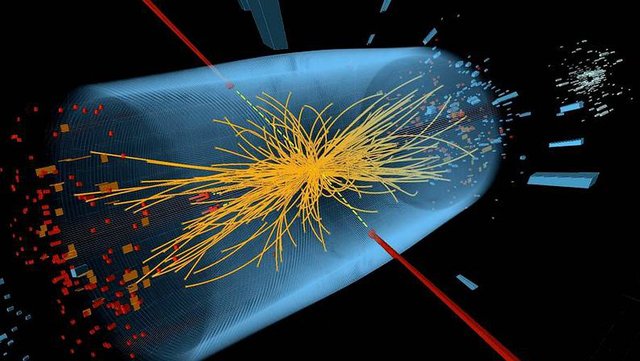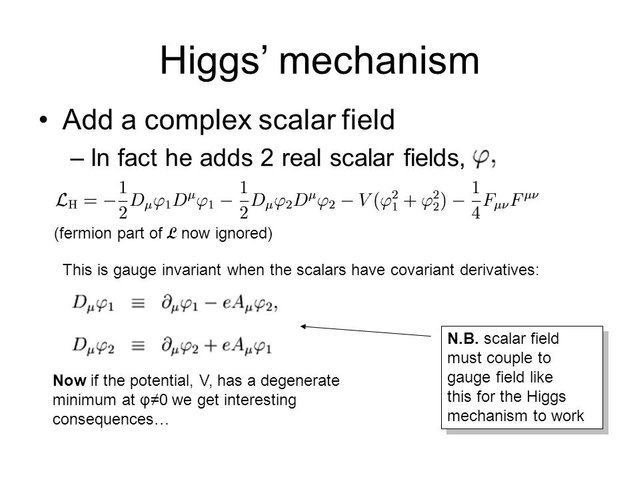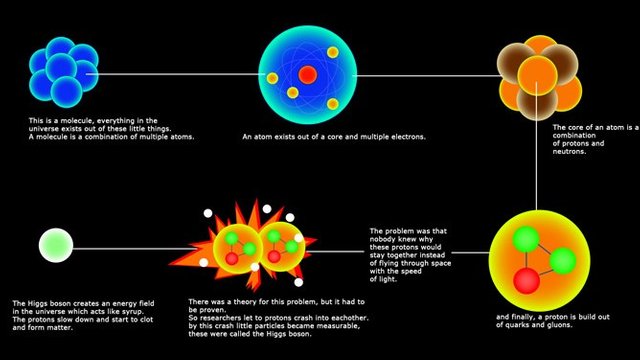Higgs Boson: The particle of god!
Hi stemers today I'm going to talk about an interesting subject: The particle of god
Is very controversial subject, But today I'll explain it as easy as I can after a little research that I made by my self
Let's start with a concept:
What is the Higgs boson?
It is a type of elementary particle that is believed to have a fundamental role in the mechanism by which mass originates in the Universe. The confirmation or refutation of its existence is one of the objectives of the Large Hadron Collider (LHC), the largest and most powerful particle accelerator in the world operated by the European Laboratory for Particle Physics (CERN) in the Franco-Swiss border, near Geneva.

Why is the Higgs boson so important?
Because it is the only particle predicted by the Standard Model of Particle Physics that has not been discovered yet. The standard model perfectly describes the elementary particles and their interactions, but an important part remains to be confirmed, precisely the one that responds to the origin of the mass. Without mass, the Universe would be a very different place. If the electron had no mass there would be no atoms, which would not exist the matter as we know it, so there would be no chemistry, no biology, and we would not exist ourselves.
To explain this, several physicists, among them the British Peter Higgs, postulated in the 60s of the 20th century a mechanism known as the Higgs field. Just as the photon is the fundamental component of the electromagnetic field and light, the Higgs field requires the existence of a particle that composes it, which physicists call the Higgs boson.
How does the Higgs mechanism works?
The Higgs field would be a kind of continuum that extends throughout the space, formed by an uncountable number of Higgs bosons. The mass of the particles would be caused by a "friction" with the Higgs field, so the particles that have a greater friction with this field have a greater mass.

What is a boson?
Subatomic particles are divided into two types: fermions and bosons. Fermions are particles that make up the matter, and bosons carry forces or interactions. The components of the atom (electrons, protons, and neutrons) are fermions, while the photon, the gluon and the W and Z bosons, responsible respectively for the electromagnetic, strong nuclear and weak nuclear forces, are bosons greater.
How can the Higgs boson be detected?
The Higgs boson cannot be detected directly because once it is produced it disintegrates almost instantaneously giving rise to other, more familiar, elementary particles. What you can see are their "fingerprints", those other particles that can be detected in the LHC.
Inside the accelerator ring, protons collide with each other at a speed close to that of light. When collisions occur at strategic points where large detectors are located, the energy of the movement is released and available to generate other particles. The higher the energy of the particles that collide the more mass the resulting ones can have, according to the famous Einstein E2 equation.
Because the theory does not establish its mass but a wide range of possible values, very powerful accelerators are required to explore this new territory of Physics. The LHC is the culmination of an "energy escalation" aimed at discovering the Higgs boson in particle accelerators. When it reached its maximum power in 2014, the LHC collided protons at an energy close to 14 teraelectronvolts (TeV). Currently, it works to something more than half, 8 TeV. In any case, if it exists, the Higgs particle will be produced in the LHC. When will we know if the Higgs boson has been found? In Particle Physics, the concept of observation is defined statistically in terms of standard deviations or "sigmas", which indicate the probability that an experimental result is due to chance rather than chance. of being a real effect. To achieve greater statistical significance, and therefore increase the probability of observation, the experiments need to analyze a lot of data.
The LHC generates about 300 million collisions per second, so the amount of data to analyze is huge. It is measured in inverse femtobarns, a unit that gives an idea of the number of collisions that occur in a particle accelerator per unit area and time (luminosity). If a measure has five sigmas of certainty level, it is called "observation". To reach five sigmas we would have to draw face more than 20 times in a row, a probability lower than 0.00006%. To be sure that an observation corresponds to a Higgs boson of the Standard Model and not to another different particle, it will be necessary to study in detail and with more data the properties of the new particle. Specifically, if the way in which it occurs and disintegrates is in accordance with what was predicted by the theory or not, which would be even more interesting.

What do we know about the Higgs boson so far?
Direct searches carried out in previous particle accelerators such as the LEP of CERN and Tevatron, from the Fermi Laboratory of the United States, established that the mass of the Higgs boson must be greater than 114 GeV (gigaelectronvolts; 1 gigaelectronvolt approximately equivalent to the mass of a proton). Other indirect evidence observed in physical processes involving the Higgs boson ruled out a mass greater than 158 GeV.
Results on the search for the Higgs boson at the LHC were presented at CERN in December 2011, obtained from five femtobarn datasets collected since 2010. These results showed that the most likely mass range is between 116 and the 130 GeV (gigaelectronvolts), according to the ATLAS experiment, and between 115 and 127 GeV, according to the CMS experiment. The most interesting thing is that the two large experiments of the LHC saw indications of its presence in the region between 124 and 126 GeV.
Benefits for the society of particle physics
The technology developed in particle accelerators has indirect benefits for Medicine, Information Technology, industry or the environment. The superconducting magnets that are used to accelerate the particles have been fundamental to develop diagnostic imaging techniques such as magnetic resonance imaging.
The detectors used to identify the particles are the basis of PET, positron emission tomography (electron antiparticle). And more and more medical centers are using particle beams as cancer therapy.
The World Wide Web (WWW), the language on which the Internet is based, was created at CERN by Tim Berners-Lee to share information among scientists located around of the world, and the large amounts of data produced by particle accelerators motivate the development of a distributed global computing network called GRID.
The particle beams produced in synchrotron type accelerators or neutron spallation sources, instruments created by physicists to test the nature of matter, have industrial applications in the determination of the properties of new materials, as well as to characterize biological structures or new drugs. Other applications of particle physics are the manufacture of solar panels, sterilization of food containers or reuse of nuclear waste, among many other fields.
For more information you can check the following books
- LHC Higgs Cross Section Working Group; Dittmaier; Mariotti; Passarino; Tanaka; Alekhin; Alwall; Bagnaschi; Banfi (2012).
- Csaki, C.; Grojean, C.; Pilo, L.; Terning, J. (2004). "Towards a realistic model of Higgsless electroweak symmetry breaking"
- Onyisi, P. (23 October 2012). "Higgs boson FAQ". University of Texas ATLAS group. Retrieved 2013-01-08.
Why are you asking these two complementary questions:
Do you know that the Higgs boson was actually discovered more than 5 years ago?
Well, currently, the LHC is not working... This is why steemSTEM will do down inside it in two weeks. But before the shutdown, the collision energy was not 8 TeV... the 8 TeV run ended early in 2013...
Maybe, just maybe.. He is a time traveler from the past? Or maybe he missed the memo :/